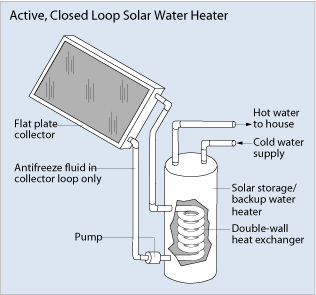There’s more than one way to tap into clean, renewable, free energy from the sun. You can install a photovoltaic, or PV system, where solar panels convert the sun’s rays into electricity. But you could also choose a straightforward, efficient, and cheaper solar option: solar thermal water heating.
A solar thermal system simply uses solar collectors to capture the sun’s energy, in order to heat water, another fluid, or air. Collectors can be either “evacuated tubes” or “flat plate” collectors; in either case, the heart of a solar thermal collector is an absorber that converts the sun’s energy into heat. The heat is then transferred by circulating the water, glycol (a non-toxic fluid found in antifreeze), or sometimes air to another location, where it is either stored or used immediately.

Unlike PV, solar thermal technology won’t power your whole home; but it will provide for nearly all of your hot water needs throughout the year. It will also only cost you a fraction of the price of a PV system – as little as $6,000 – and will pay itself off in less time – about 6 years on average. Not to mention that once installed, a solar thermal system emits no toxins or CO2, does not rely on fossil fuels, and brings our society one small step closer to energy independence and a true, active environmental awareness.
A single gas- or oil-fired water heater contributes about 2 tons of CO2 to the atmosphere annually. The average electric water heater creates about 8 tons of CO2 in a year, or about double the amount of an average car. In total, residential hot water heating in the US creates about 148 million metric tons of CO2 every year – or about the same as 22 million cars! Solar thermal is an environmentally friendly, fossil-fuel-free, and carbon-free alternative to conventional hot water heating systems.
Solar thermal hot water heating is a fairly straightforward system. A flat-plate collector or evacuated-tube collector is mounted on a rooftop, facing south, angled to catch as much direct sunlight as possible and to avoid all sources of shade. Most often, in the case of a flat-plate collector, the sun heats coils of copper pipe inside the collector, which transfer the heat to a non-toxic propylene glycol liquid as it slowly moves through the collector. When the liquid is hot enough, it flows down into the household hot water tank, and transfers the heat to the water via a coiled heat exchanger, before then circulating back up the collectors. The glycol never comes in contact with the domestic hot water. Valves in the system prevent the glycol from superheating, and by its chemical nature it won’t freeze, and therefore won’t damage the components of the solar collector. The collectors can heat hot water even with very little sun, and the hot water tank can store hot water for days; even so, every solar thermal system is designed with a back-up heat source just in case, so there won’t be any surprise cold showers.

Solar thermal technology has been around for centuries, although modern improvements have made systems much more efficient than in the past. Back in 1897 when heating water with coal was becoming too expensive in much of the US, Clarence Kemp designed “Kemp’s water heaters”, a solar-heated water system which for a time was used by more than one-third of Pasadena, CA residents. Currently the US is lagging behind other countries in utilizing solar thermal systems. In places like Israel, fully dependent on imported fuels to power the country, solar thermal hot water systems are found on 90% of residential buildings. Operating at an average annual efficiency of 50%, these systems save residents about 2000 kWh in yearly electricity costs. Cyprus leads Europe in solar thermal, with systems installed in 88% of homes. Cyprus is followed by Greece with 65% coverage, and then Austria with 15%. The governments of all of these countries point to the economic, political, as well as ecological benefits of using solar thermal on a massive scale.
Solar thermal systems are one of the smartest investments in solar energy. Here in New England, the average home uses 17% of its energy on water heating alone; a properly installed solar thermal system will take care of up to 100% of a home’s summertime hot water, up to 70% of wintertime hot water, or about 55-85% of a home’s year-round hot water needs. A new system will last anywhere from 15 to 40 years; but with the energy savings it brings, it will have paid itself off in only about 6 years. Maintenance costs are low: the system should be checked just once a year, and if a system uses glycol, it may have to be replaced just once every 3 to 10 years.
Professional solar thermal installers know how to make sure that a solar thermal system suits a family. In general, 20 square feet of solar collector surface area is needed for the first two people in a home, with 8 square feet for each additional person in sunny zones, or 12-14 square feet for each additional person in the northern US. For every square foot of solar collector surface area, a household will need at least 1.5 gallons of storage capacity. Collectors and tanks are designed with these ratios in mind. Installers should also provide free solar thermal site assessments, helping consumers to understand the full benefits of a solar thermal system before making a decision.
SOURCES:
US Energy Information Administration
http://www.eia.doe.gov/emeu/steo/pub/contents.html
The Alternative Energy Store
http://www.altenergystore.com/
DSIRE
http://www.dsireusa.org/
Sunnovations
http://www.sunnovations.com/
EERE
http://www.eere.energy.gov/
NESEA
http://www.nesea.org/
The Complete Idiot’s Guide to Renewable Energy for Your Home
http://www.amazon.com/Complete-Idiots-Guide-Renewable-Energy/dp/1592579175
Israel Ministry of Foreign Affairs
http://www.mfa.gov.il/MFA/Facts%20About%20Israel/Science%20-%20Technology/Solar%20Energy%20in%20Israel
Justice for Cyprus
http://news.pseka.net/index.php?module=article&id=8451

